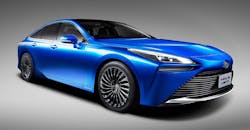In 2015, Toyota debuted the Mirai, the first production hydrogen fuel-cell electric vehicle (FCEV) offered for sale to retail customers in North America. Now, Toyota has revealed the second-generation Mirai, which means “future” in Japanese, to go on sale in late 2020 rebooted as a premium sedan.
Toyota has targeted a 30% increase in range, achieved by an improvement in fuel-cell system performance and greater hydrogen storage capacity. In addition, the automaker claims the new Mirai will offer a more powerful, engaging, and even quieter driving experience than its pioneering forerunner.
“I want customers to say, ‘I chose the Mirai not because it’s an FCEV, but because I really wanted this car, and it just happened to be an FCEV’,” says Yoshikazu Tanaka, Chief Engineer of the Mirai.
At its core, the Mirai is an electric vehicle, but it never needs to be plugged in to recharge. An FCEV generates its own electricity onboard from hydrogen and oxygen, with water as the only tailpipe emission. Among the advantages of FCEV technology is a quick refueling time—a fill-up takes just about five minutes at an SAE-conforming hydrogen fueling station in California or Hawaii (with stations also planned for the Northeast and other areas).
Toyota’s second-generation Mirai offers a 30% increase in range.
Fuel cells have been studied before by the automotive sector, but the technology only recently became practical and cost-effective. Toyota began its fuel-cell development around the same time as it came out with the original Prius more than 20 years ago; the Mirai shares some of the technology and components from the company’s hybrid program. Toyota developed the solid-polymer electrolyte fuel cells used in the first- and second-generation Mirai models, and to help foster FCEV proliferation, the company released its patents, royalty-free.
Mirai’s fuel cell is composed of an anode, cathode, and electrolyte membrane. Hydrogen is passed through the anode, and oxygen through the cathode. The hydrogen molecules are split into electrons and protons. As protons pass through the electrolyte membrane, electrons travel along a circuit, generating an electric current and heat. At the cathode, the protons, electrons, and oxygen combine to produce water molecules. There are no other byproducts.
Toyota projects that fuel-cell electric technology will one day be as common as the company’s hybrid electric technology.
The second-generation Mirai is built on a rear-wheel drive platform, a major departure from the original front-wheel drive version in terms of design. The new platform allows for a rigid body that’s lower, longer, and wider, with its stance accentuated by 20-in. alloy wheels.
By taking advantage of the new platform, there’s more interior space, thus allowing for five-passenger seating. The vehicle’s dash includes a standard 8-in. digital combination cluster screen and an available digital rearview mirror that displays images from a rear camera. The standard Toyota Premium Multimedia system, which uses a 12.3-in. high-resolution TFT touchscreen, includes navigation and a 14-speaker JBL sound system.
Toyota says hydrogen fuel-cell technology is a scalable technology, which means it can be made small enough to power a phone or large enough to power a building, or anything in between. For example, Toyota installed fuel-cell powertrains into a test fleet of Kenworth class-8 semi-trucks that can pull a maximum 80,000-lb. load. These zero-emission big rigs are currently used to move freight in and around the Ports of Long Beach and Los Angeles, California.


